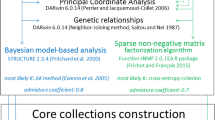Abstract
An algorithm of automatic classification is proposed and applied to a large collection of perennial ryegrass wild populations from France. This method is based on an ascendant hierarchical clustering using the Euclidian distance from the principal components extracted from the variance-covariance matrix between 28 agronomic traits. A contiguity constraint is imposed: only those pairs of populations which are defined as contiguous are grouped together into a cluster. The definition of contiguity is based on a geostatistical parameter: the range of the variogramme, i.e. the largest distance above which the variance between pairs of population no longer increases. This method yields clusters that are generally more compact than those obtained without constraint. In most cases the contours of these clusters fit well with known ecogeographic regions, namely, for macroclimatic homogeneous conditions. This suggests that selective factors exert a major influence in the genetic differentiation of ryegrass populations for quantitatively inherited adaptive traits. It is proposed that such a method could provide useful genetic and ecogeographic bases for sampling a core collection in widespread wild species such as forage grasses.
Similar content being viewed by others

References
Balfourier F, Charmet G, (1991) Relationships between agronomic characters and ecogeographical factors in a collection of french perennial ryegrass populations. Agronomie 11:645–657
Brown AHD (1989) The case for core collection. In: Brown AHD, Frankel OH, Marshall DR, Williams JT (eds) The use of plant genetic resources. Cambridge University Press, Cambridge, UK, pp 136–156
Charmet G, Balfourier F, Bion A (1990) Agronomic evaluation of a collection of French perennial ryegrass populations: multivariate classification using genotype x environment interactions. Agronomie 10:807–823
Charmet G, Balfourier F, Ravel C (1993) Isozyme polymorphism and goegraphic differentiation in a collection of French perennial ryegrass populations. Genet Resources Crop Evol (in press)
Erskine W, Adham Y, Holly L (1989) Geographic distribution of variation in quantitative traits in a world lentil collection. Euphytica 43:97–103
Falcinelli M, Veronesi F, Lorenzetti S (1988) Evaluation of an Italian germplasm collection of Lolium perenne L. through a multivariate approach. In: Poisson C (ed) Natural variation and breeding for adaptation. Proc EUCARPIA Fodder Crops Sect Meet. Lusignan, France, pp 23–35
Felsenstein J (1983) Numerical taxonomy. Springer, Berlin Heidelberg New York Tokyo
Fisher MM (1978) Zur Lösung funktionaler regionaltaxonomischer Probleme auf der Basis von Interaktionmatrizen: ein neuer graphentheoretischer Ansatz. Karlsruher Manuskr Math Theor Wirtsch. Sozialgeogr no. 25
Gabriel KR, Sokal RR (1969) A new statistical approach to geographic variation analysis. Syst Zool 18:259–270
Goledshalk EB, Timothy DH (1988) Factor and principal component analyses as alternatives to index selection. Theor Appl. Genet 76:352–360
Guy P, Ghesquiere M, Charmet G, Prosperi JH (1990) Pooling accessions. Advantages and disadvantages. In: Report working group on forages. IBPGR, Rome, pp 35–49
Humphreys MO (1991) A genetic approach to the multivariate differentiation of perennial ryegrass (Lolium perenne L.) populations. Heredity 66:437–443
Lebart L (1978) Programme d'agrégation avec contraintes (C.A.H. contiguité). Cah Anal Données 3:275–287
Lefkovitch LP (1980) Conditional clustering. Biometrics 36:43–58
Mandel J (1971) A new analysis of variance model for non-additive data. Technometrics 13:1–18
Monestiez P (1978) Présentation de deux méthodes utilisant la notion de contiguité pour l'analyse des données géographiques. PhD thesis, University of Pierre et Marie Curie, Paris
Monestiez P, Goulard M, Charmet G (1994) Geostatistics for spatial genetic structures: study of wild populations of perennial ryegrass. Theor Appl Genet (in press)
Oliver MA, Webster R (1989) A geostatistical basis for spatial weighting in multivariate classification. Math Geol 21:19–35
Peeters JP, Martinelli JA (1989) Hierarchical cluster analysis as a tool to manage variation in germplasm collection. Theor Appl Genet 78:42–48
Peeters JR, Wilkes HG, Galwey NW (1990) The use of ecogeographical data in the exploitation of variation from gene banks. Theor Appl Genet 80:110–112
Perruchet C (1979) Classification sous contrainte de contiguité continue: application aux sciences de la terre. Thèse 3ème cycle, University of Pierre et Marie Curie, Paris
Sokal PR, Oden NL (1978) Spatial autocorrelaation in biology. 2. Some biological implications and four applications of evolutionary and ecological interest. Biol J Linn Soc 10:229–249
Tyler BF (1987) Collection, characterization and utilization of genetic resources of temperate grass and clover. IBPGR Training Courses, Lecture Ser1, p 66. IBPGR, Rome, Italy
Weltzien E (1989) Differentiation among barley landrace populations from the Near East. Euphytica 43:29–39
Wright S (1978) Evolution and the genetics of populations, vol 4: variability within and among natural populations. University of Chicago Press, Chicago, USA
Yonezawa K (1985) A definition of the optimal allocation of effort in conservation of plant genetic resources with application to sample size determination for field collection. Euphytica 34:345–354
Author information
Authors and Affiliations
Additional information
Communicated by P. M. A. Tigerstedt
Institut National de la Recherche Agrononique
Rights and permissions
About this article
Cite this article
Charmet, G., Balfourier, F. & Monestiez, P. Hierarchical clustering of perennial ryegrass populations with geographic contiguity constraint. Theoret. Appl. Genetics 88, 42–48 (1994). https://doi.org/10.1007/BF00222392
Received:
Accepted:
Issue Date:
DOI: https://doi.org/10.1007/BF00222392



